Gynecomastia Reduction
Male Breast Reduction Surgery in Carmel, IN
Gynecomastia reduction surgery is available to male patients suffering from abnormal and embarrassing breast enlargement from Dr. Barry Eppley. He has extensive experience with male breast reduction and has compiled an extensive amount of information and a male breast reduction before and after results page to provide potential patients with an overview of the procedure.
TODAY’S MALE CHEST RESHAPING CONCERNS
 While the treatment of male chest enlargement has been around for many decades, the aesthetic standards of today are changing the type of male patient who presents with chest shape concerns. In days past the ‘typical’ gynecomastia patient was a teenager who was embarrassed by having very visible and evident breast mounds. While that type of gynecomastia patient still exists, a much wider age range and types of chest problems are being seen. More discrete issues such as protruding nipples, large areolas, puffy nipple-areolar complexes and deflated and saggy chests in older men have presented a whole new set of gynecomastia issues that ever before. Men want a completely flat chest with no nipple protrusion with tight skin that does not jiggle.
While the treatment of male chest enlargement has been around for many decades, the aesthetic standards of today are changing the type of male patient who presents with chest shape concerns. In days past the ‘typical’ gynecomastia patient was a teenager who was embarrassed by having very visible and evident breast mounds. While that type of gynecomastia patient still exists, a much wider age range and types of chest problems are being seen. More discrete issues such as protruding nipples, large areolas, puffy nipple-areolar complexes and deflated and saggy chests in older men have presented a whole new set of gynecomastia issues that ever before. Men want a completely flat chest with no nipple protrusion with tight skin that does not jiggle.
GYNECOMASTIA PRESENTS IN DIFFERENT FORMS AT DIFFERENT AGES
Enlargement of the male chest due to the development of breast tissue can occur at any age. There are a wide range of influences that may stimulate the growth of a breast mound from the teenage years to senior citizen status. But how to best perform gynecomastia reduction surgery is not the same at all ages and must take into consideration the size and firmness of the breast tissue, the quality of the overlying skin, the position and size of the nipple as well as the fullness of the pectoralis muscles.
Teenage Gynecomastia
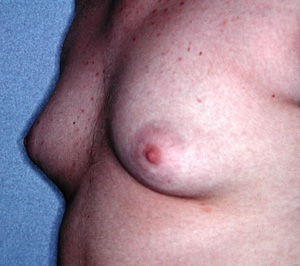
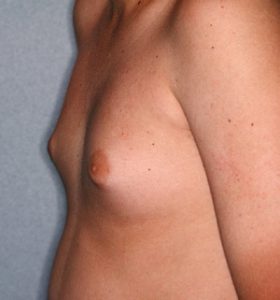 The development of breasts in the young male most commonly occurs during the early teenage years due to hormonal influences and usually recedes by the mid-teenage years. For an unfortunate few teenagers, however, the breast tissue fails to recede and is a cause of considerable dismay and embarrassment. Such forms of young male breast enlargement can range from a ‘puffy nipple’ to the appearance of a much larger breast mound. The aesthetic demands of the younger male are the desire for a completely flat chest wall with no nipple protrusion.
The development of breasts in the young male most commonly occurs during the early teenage years due to hormonal influences and usually recedes by the mid-teenage years. For an unfortunate few teenagers, however, the breast tissue fails to recede and is a cause of considerable dismay and embarrassment. Such forms of young male breast enlargement can range from a ‘puffy nipple’ to the appearance of a much larger breast mound. The aesthetic demands of the younger male are the desire for a completely flat chest wall with no nipple protrusion.
Young to Middle-Aged Gynecomastia
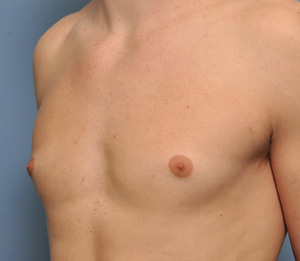
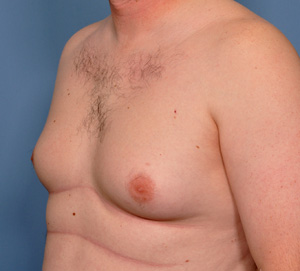 Even if a man has not had breast enlargement during adolescence, breast tissue can still develop due to pharmacologic and supplement influences. Common examples include marijuana use, drugs such as propecia, steroids and chemotherapy agents, numerous body building supplements and weight gain Most gynecomastias present at this age with a protruding nipple due to an underlying glandular breast mass or larger and softer overall chest enlargement.
Even if a man has not had breast enlargement during adolescence, breast tissue can still develop due to pharmacologic and supplement influences. Common examples include marijuana use, drugs such as propecia, steroids and chemotherapy agents, numerous body building supplements and weight gain Most gynecomastias present at this age with a protruding nipple due to an underlying glandular breast mass or larger and softer overall chest enlargement.
Silver (Older) Gynecomastia
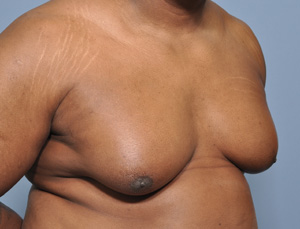
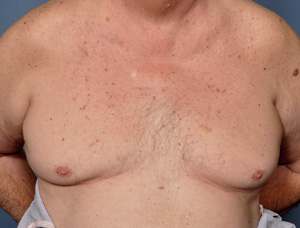 In the older male, breast enlargement may also occur although far less frequently than in the hormonally-changing adolescent. Age, certain medications and lower testosterone levels can result in the development of embarrassing breast enlargement that is easily seen to jiggle through shirts. Combined with loose skin and a sagging chest with aging, the older male gynecomastia presents with a loose skin issue that most younger and middle-aged males do not have. Their pectoralis muscle has also undergone some atrophy further contributing to an overall chest ‘sag’.
In the older male, breast enlargement may also occur although far less frequently than in the hormonally-changing adolescent. Age, certain medications and lower testosterone levels can result in the development of embarrassing breast enlargement that is easily seen to jiggle through shirts. Combined with loose skin and a sagging chest with aging, the older male gynecomastia presents with a loose skin issue that most younger and middle-aged males do not have. Their pectoralis muscle has also undergone some atrophy further contributing to an overall chest ‘sag’.
Weight Loss Severe Gynecomastia
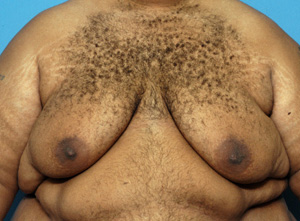 The severe form of gynecomastia is caused by significant weight, usually in the range of 75 lbs or more. Just like in the female, the large chest skin envelope deflates and the looser skin sack falls carrying with it the nipple. This type of chest problem poses the ‘ultimate’ gynecomastia reduction/chest reshaping challenge.
The severe form of gynecomastia is caused by significant weight, usually in the range of 75 lbs or more. Just like in the female, the large chest skin envelope deflates and the looser skin sack falls carrying with it the nipple. This type of chest problem poses the ‘ultimate’ gynecomastia reduction/chest reshaping challenge.
GYNECOMASTIA REDUCTION SURGERY TECHNIQUES
Gynecomastia surgery represents a range of surgical techniques that can incorporate breast tissue removal by liposuction and/or open excision, nipple lifting and/or areolar reduction and pectoral muscle augmentation by implant or fat grafting. It is important to carefully analyze before surgery what tissue elements make up the presenting gynecomastia and then apply the surgical techniques that would best reduce it.
Liposuction
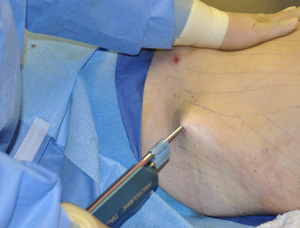 If the breast tissue is soft and non-glandular (not firm or nodular), liposuction alone may be sufficient to flatten the chest wall. While offering the simplest form of gynecomastia surgery, liposuction is often not enough to achieve the desired result and its use alone is a frequent source of patient dissatisfaction with their results.
If the breast tissue is soft and non-glandular (not firm or nodular), liposuction alone may be sufficient to flatten the chest wall. While offering the simplest form of gynecomastia surgery, liposuction is often not enough to achieve the desired result and its use alone is a frequent source of patient dissatisfaction with their results.
While there are many different types and branded names of liposuction, few have been proven to be superior to another. None have any magical properties when it comes to skin tightening/retraction. My preferred choice at his time is either laser liposuction (Smartlipo) or power-assisted liposuction (PAL). Removing the usually fibrotic tissue of the male breast requires a liposuction technology that works effectively in this type of fat.
Open Areolar Excision
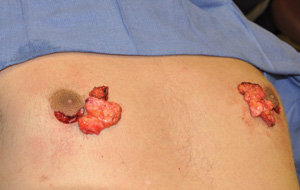 Open excision through an areolar incision can remove the very nodular tissue that lies underneath and around the nipple-areolar complex and is often a more effective approach to achieve maximal breast tissue removal. Liposuction is then used to feather the shape of the chest wall around the breast tissue that has been openly excised.
Open excision through an areolar incision can remove the very nodular tissue that lies underneath and around the nipple-areolar complex and is often a more effective approach to achieve maximal breast tissue removal. Liposuction is then used to feather the shape of the chest wall around the breast tissue that has been openly excised.
Nipple Lift and Periareolar Reduction
In sagging chest skin, a superior nipple lift (crescent nipple lift) or a peri-areolar reduction can help lift a low nipple position upward, make a more normal male areolar size and provide a limited amount of chest skin tightening. In some cases a nipple reduction can be performed later to reduce any protrusion.
Horizontal Gynecomastia Excision with Nipple Transposition/Free Nipple Grafting
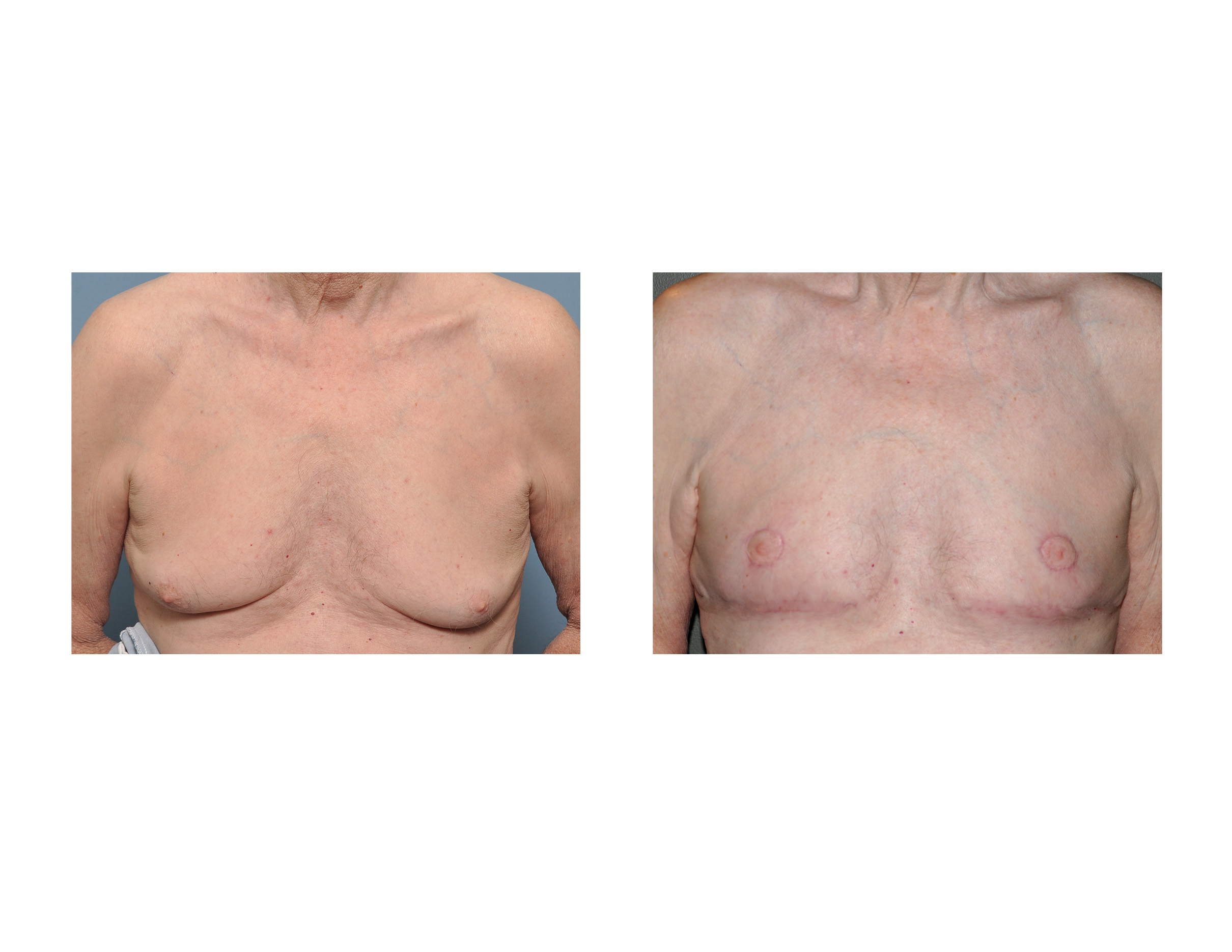
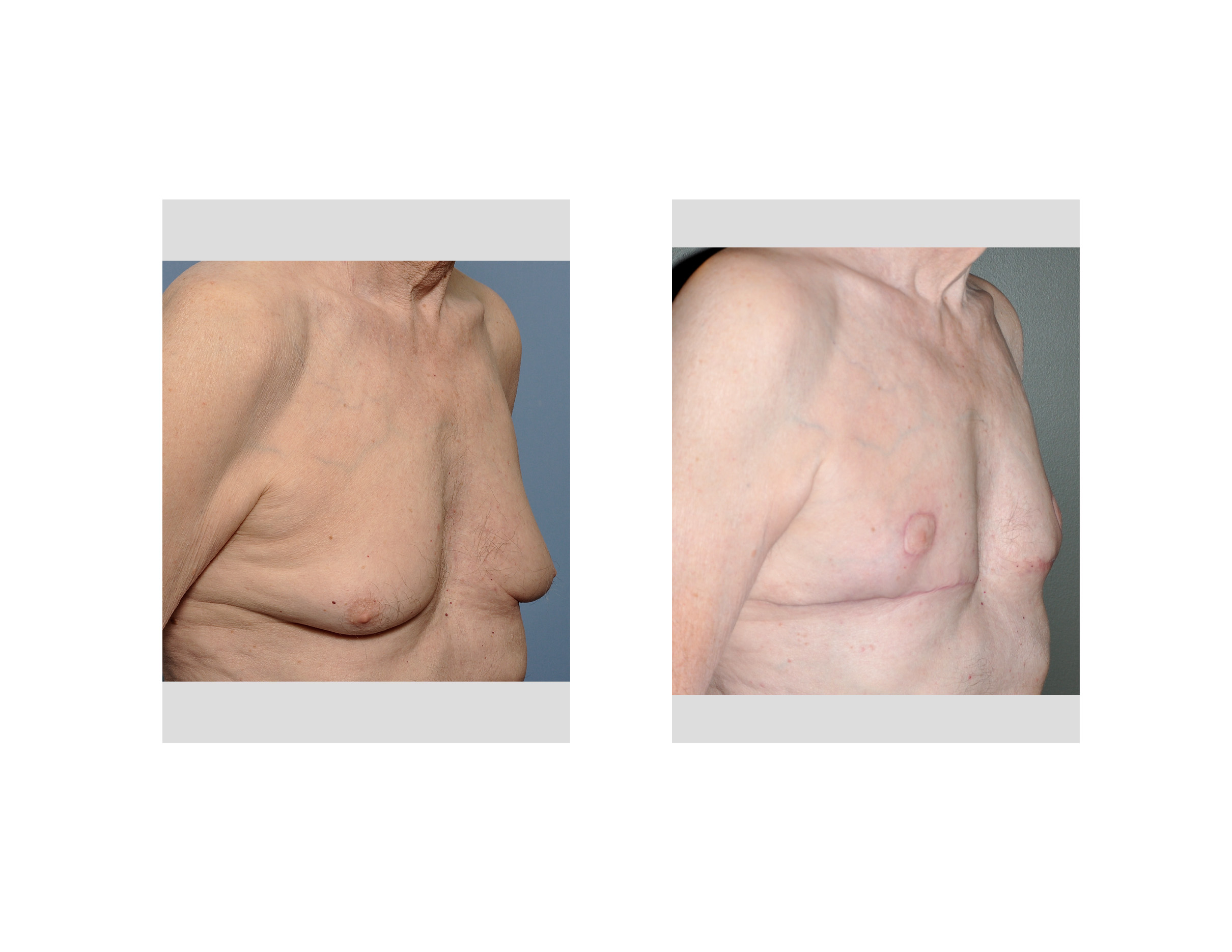 In the most severe forms of gynecomastia where the breast mound hangs well below the inframammary crease, none of the traditional gynecomastia reduction strategies will work. There simply is too much skin and the nipple position is too low. This can occur after significant weight loss from bariatric surgery or dieting. In these cases, the extreme version of a male breast reduction is done by removing the overhang and transferring the nipple on a de-epithelized breast glandular flap up into a new higher position. In rare cases, the nipple may be removed and put back as a free nipple graft.
In the most severe forms of gynecomastia where the breast mound hangs well below the inframammary crease, none of the traditional gynecomastia reduction strategies will work. There simply is too much skin and the nipple position is too low. This can occur after significant weight loss from bariatric surgery or dieting. In these cases, the extreme version of a male breast reduction is done by removing the overhang and transferring the nipple on a de-epithelized breast glandular flap up into a new higher position. In rare cases, the nipple may be removed and put back as a free nipple graft.
Pectoral Implants
In the older male chest, pectoral muscle augmentation with an implant or fat injection grafting can restore or create upper chest fullness. By providing volume over the muscular part of the chest, it blends better into the lower chest and helps pick up any loose skin from the reduction to create a rejuvenated chest appearance.
MALE NIPPLE REDUCTION
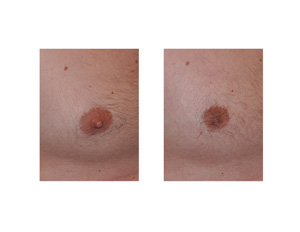 While not always associated with gynecomastia, and often is not, enlarged or protruding nipples are a small but very bothersome problem for some men. The protruding nipple constantly sticks out well beyond the areolar base, may or may not be hard and is very visible through shirts. Reduction of long or protruding nipples can be done as a simple office procedure under local anesthesia or as part of a larger gynecomastia reduction procedure. Partial or complete nipple reduction can be done based on the patient’s choice of some remaining nipple projection or to have a completely flat nipple-areolar complex profile.
While not always associated with gynecomastia, and often is not, enlarged or protruding nipples are a small but very bothersome problem for some men. The protruding nipple constantly sticks out well beyond the areolar base, may or may not be hard and is very visible through shirts. Reduction of long or protruding nipples can be done as a simple office procedure under local anesthesia or as part of a larger gynecomastia reduction procedure. Partial or complete nipple reduction can be done based on the patient’s choice of some remaining nipple projection or to have a completely flat nipple-areolar complex profile.
Gynecomastia Reduction – Before Surgery
In the adolescent or mature male, the development of gynecomastia usually merits both a thorough physical examination to rule out breast cancer (which does occur in males but very rarely) and, in some cases, an endocrinologic evaluation to rule out any treatable hormonal causes of the breast enlargement. In the overwhelming majority of cases, however, no definable cause is usually found.
Gynecomastia, depending upon the amount of excess breast tissue and skin that is present, may be treated by several different techniques. These can include liposuction, open breast tissue excision through an areolar incision, and nipple lifting through either a superior or peri-areolar method. Most gynecomastia surgeries utilize a combination of open excision and liposuction for the best result. In larger gynecomastia problems, a horizontal elliptical excision of skin, liposuction and nipple transposition may be needed. This is somewhat similar to breast reduction in females but without the vertical scar between the nipple and the inframammary fold. Which technique is best will be determined and discussed prior to your surgery.
Gynecomastia Reduction – Operation
Gynecomastia reduction is almost always performed as an outpatient under general anesthesia. In liposuction only procedures, an incision is made either around the nipple or in a lower skin fold. The breast tissue/fat is removed through a suction cannula. Frequently, a laser-liposuction (Smartlipo) technique is used. In open excisions, an incision is made around the lower half-circle of the nipple and tissue removed through this exposure. Liposuction is then done to feather the breast mound into the surrounding chest wall. In larger breast mounds, some concomitant reduction of skin is needed. This usually involves removing a circle of skin around the nipple (circumareolar technique), excising breast tissue and liposuction is performed through this open area, and the larger circle of skin sewn to the smaller nipple. Regardless of technique, all incision are closed with dissolvable sutures. In open excision gynecomastia techniques, drains are often used and remain in place for several days after surgery.
Gynecomastia Reduction Recovery
Dressings usually consist of a circumferential chest wrap which applies significant compression. Postoperative compression of the chest is important to reduce potential fluid accumulation and help the skin adapt down and create the improved chest contour. These wraps are usually removed in 2 to 3 days and a light binder worn for several weeks thereafter. In cases of large gynecomastia reduction, surgical drains may be used for up to a week after surgery.
Complications from gynecomastia correction are uncommon and their occurrence is usually related to the size of the reduction needed. In large reductions, the most frequent complication is a seroma (fluid collection) which usually requires drainage. Optimally matching the shape of the chest on both sides may require a second procedure.

North Meridian Medical Building
Address:
12188-A North Meridian St.
Suite 310
Carmel, IN 46032
Contact Us:
Phone: (317) 706-4444
WhatsApp: (317) 941-8237
